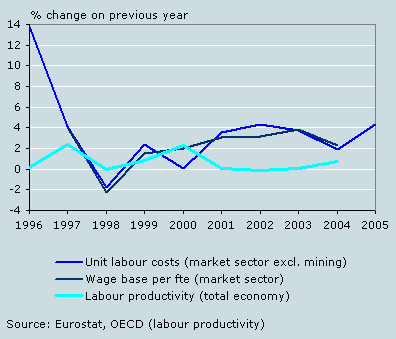Wage costs, labour productivity and unit labour costs

A decrease in labour costs per unit of output is usually good for competitiveness and exports. Whether unit labour costs rise or fall is not only determined by wage developments, but also by changes in labour productivity. This focus article analyses developments in unit labour costs in a number of eurozone countries using developments in wage costs and labour productivity. Rising wages do not necessarily lead to higher unit labour costs, and thus a weakening competitiveness and lower exports. A relatively moderate increase in wage costs may result in constant or decreasing unit labour costs if labour productivity increases at the same rate or by more.
Preliminary remarks
The available data for wage costs, unit labour costs and labour productivity are not completely compatible. The problem is that wage developments and unit labour costs refer to market sector wages and output, while labour productivity data (except those for the Netherlands) refer to the whole economy. The development in market sector labour productivity is generally larger than that for the total economy. In spite of this, a qualitative analysis reveals a number of interesting developments.
Wage costs development very moderate in Germany
Two possible developments may cause a decrease in unit labour costs. First, wage costs can fall, or rise only very moderately. This has been the case in Germany in recent years. Compared with other European countries, the increase in market sector wage costs has been very moderate.
Wage base, productivity and unit labour costs in Germany

Labour productivity growth in Finland
The second possibility to reduce unit labour consists is by using labour input more efficiently. An increase in labour productivity means that less labour is needed to realise a unit of output. The effect this will have on unit labour costs depends on the difference in development between the rise in wage costs and the rise in labour productivity.
If labour productivity rises by enough, a significant rise in labour costs will not necessarily mean that unit labour costs also increase strongly. This can be seen clearly in Finland. On average, the market sector annual wage there has risen quite substantially in the last ten years, but the unit labour costs have risen hardly or not at all. This is because labour productivity has also risen quite strongly.
Wage base, productivity and unit labour costs in Finland

Continuous rise in wage costs in Italy
In the opposite situation, labour productivity does not rise by enough to be able to compensate the rise in wage costs. The consequence of this is a rise in unit labour costs. This has been the situation in Italy since 2001: a stagnation in labour productivity in combination with rising wages has led to a strong increase in labour costs per unit of output.
Wage base, productivity and unit labour costs in Italy

Favourable recent developments in wage costs and productivity in the Netherlands
Developments in the Netherlands were similar to those in Italy at the beginning of this century. A slight increase in labour productivity alongside a period of strong wage rises. As a consequence, unit labour costs rose. By contrast, in recent years, labour productivity in the Netherlands has risen again, while wage costs developments have been more moderate. As a result the unit labour costs have fallen again.
Wage base, productivity and unit labour costs in the Netherlands

The developments in the Netherlands were intensified as the high economic growth turned to economic recession in 2000. Such a slowdown usually results in a lower labour productivity developments, while a return to economic growth, as in 2003, has the opposite effect. The recent developments in the Netherlands show again that unit labour costs may be the result of a moderate development in wage costs and an increase in labour productivity.